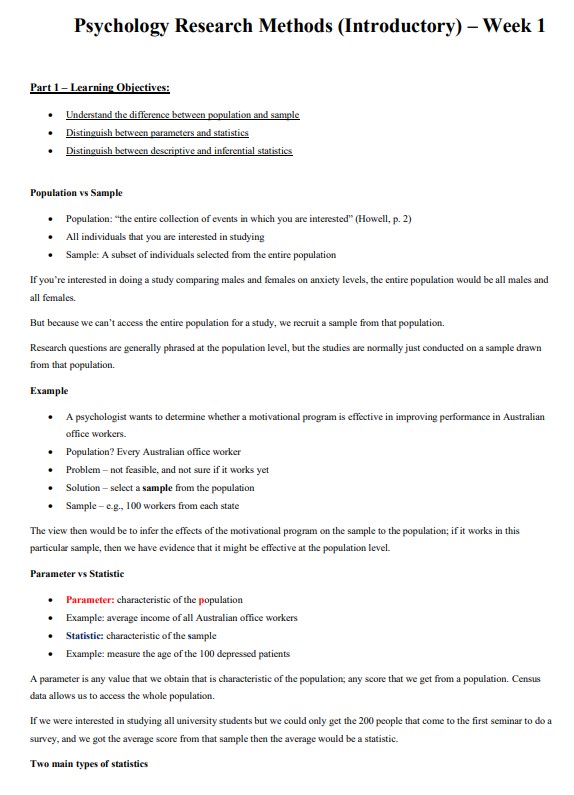Psychology Research Methods
Summary:
These notes provide a comprehensive guide to introductory psychology research methods, covering all topics and weeks of the semester and focusing on exam-relevant information. Additional notes tailored for exam revision are included.
In Part 1, the learner should grasp the differences between populations and samples, parameters and statistics, and descriptive and inferential statistics. Part 2 differentiates between discrete and continuous variables, categorical and measurement data, and independent and dependent variables.
Part 3 focuses on understanding various types of measurement scales, such as nominal, ordinal, interval, and ratio. It also provides knowledge on constructing frequency distributions, histograms, stem-and-leaf plots, and understanding positive skew, negative skew, and kurtosis.
Week 2 continues with learning objectives on understanding the concept of ‘central tendency’ and distinguishing between mean, median, and mode. It further delves into the concept of variability, and how to understand and calculate variance and standard deviation.
These notes concisely cover all the relevant content from the semester and are designed to help with exam preparation and revision.
Excerpt:
Psychology Research Methods (Introductory) – Week 1
Part 1 – Learning Objectives:
• Understand the difference between population and sample
• Distinguish between parameters and statistics
• Distinguish between descriptive and inferential statistics
Population vs Sample
• Population: “the entire collection of events in which you are interested” (Howell, p. 2)
• All individuals that you are interested in studying
• Sample: A subset of individuals selected from the entire population
If you’re interested in doing a study comparing males and females on anxiety levels, the entire population would be all males and all females.
But because we can’t access the entire population for a study, we recruit a sample from that population.
Research questions are generally phrased at the population level, but the studies are normally just conducted on a sample drawn from that population.
Example
• A psychologist wants to determine whether a motivational program effectively improves performance in Australian office workers.
• Population? Every Australian office worker
• Problem – not feasible, and not sure if it works yet
• Solution – select a sample from the population
• Sample – e.g., 100 workers from each state


Reviews